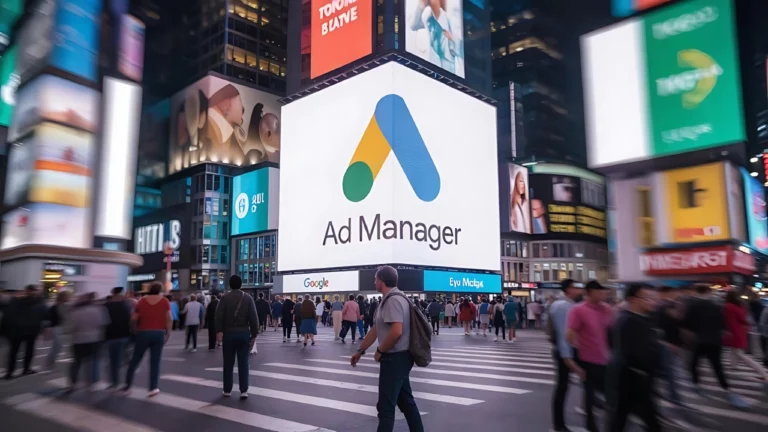AdSense vs. Google Ad Manager: Which One Is Right for Your Website?
Understanding the Platforms
If you own a website, blog, or portal and are looking to maximize your ad revenue, you’ve likely come across Google AdSense and Google Ad Manager. Both are powerful Google tools for displaying ads, but they’re designed to meet very different needs and business scales. The big question is: which one is ideal for you?
In this comprehensive guide, we’ll demystify these platforms, exploring their functionalities, advantages, and disadvantages. This way, you’ll gain clarity to make the best decision and boost your online content’s monetization.
Google AdSense: The Starting Point for Publishers
Google AdSense is the most well-known and accessible advertising solution for beginners and websites with moderate traffic. Its primary characteristic is simplicity, making it perfect for anyone who wants to start monetizing without complications.
Why choose AdSense?
Easy to use: With an intuitive interface, you can quickly set up and display ads, even without prior digital advertising experience.
Automated optimization: Google handles most of the work, selecting the most relevant ads for your audience and optimizing ad space fill rates for you.
Ideal for content creators: If your priority is creating and publishing, AdSense allows you to monetize with low maintenance, while Google manages the complexity of ad serving.
AdSense is the right choice if: your website is in its initial phase, you have a lean team (or are a solo operator), and you’re looking for an effective, low-maintenance monetization solution.
Google Ad Manager (GAM): Advanced Control for Large Publishers
Google Ad Manager (formerly DoubleClick for Publishers – DFP) is a robust and much more advanced platform, designed for large publishers, networks of websites, and media companies that demand granular control and complex optimization of their advertising operations.
Why is Google Ad Manager indispensable?
Granular control: Manage all types of inventory (web, mobile, video), set priorities for different revenue sources, and customize ad display to the fullest.
Advanced revenue optimization: Use powerful tools to maximize inventory fill rates and revenue, including direct sales management and the implementation of more sophisticated auctions like header bidding.
Unified reporting: Get detailed and customizable data from all your ad sources in one place, essential for strategic analysis and decision-making.
Scalability: It’s the tool that allows your website to grow, integrating multiple demand sources and ensuring you extract the maximum value from every impression.
Google Ad Manager is the ideal tool if: your website receives millions of monthly pageviews, you have a dedicated ad management team, and/or you engage in direct sales of ad space.
The Perfect Combination: Using AdSense and Google Ad Manager Together
It’s crucial to understand that you don’t have to choose just one. In fact, for many publishers, the smartest strategy is to use Google AdSense AND Google Ad Manager in an integrated way.
How does this powerful integration work?
Google Ad Manager acts as a central “ad server,” the conductor of your monetization orchestra. It manages and optimizes ad display from various sources, and AdSense is one of the most important demand sources it can orchestrate.
When you link your AdSense account to Ad Manager, GAM can request ads from AdSense to fill spaces that haven’t been directly sold or occupied by other networks. This process, known as “dynamic allocation” or “backfill,” is fundamental to maximizing your revenue.
Unmatched benefits of this integration:
Maximum Competition and Revenue: Ad Manager allows AdSense to directly compete with your direct sales campaigns and other ad networks. The ad that pays the most for the impression will be displayed, ensuring the highest possible revenue for each view.
Complete Inventory Fill: Never miss a monetization opportunity again! If your direct sales campaigns or other sources don’t fill all spaces, AdSense steps in as an efficient “backfill” network, guaranteeing 100% fill rates.
Centralized and Efficient Management: Manage all your ad units and demand sources (including AdSense) on a single platform, simplifying your operation and optimization.
Unified and Accurate Reporting: Get a complete view of the performance of all your ads, regardless of the source, with consolidated reports in Ad Manager.
Conclusion: Which Path to Follow for Your Website’s Monetization?
The decision between AdSense and Google Ad Manager isn’t about which one is “better” in absolute terms, but rather which one perfectly aligns with your current reality and future goals.
To start and scale with simplicity: AdSense is the ideal starting point.
For advanced optimization, granular control, and large-scale revenue maximization: Google Ad Manager is the indispensable tool.
Remember: you can start with AdSense, and as your site grows and your monetization needs become more complex, migrate to Google Ad Manager, keeping AdSense as a powerful demand source within your overall strategy. Choose the platform that will drive your success in digital monetization!


